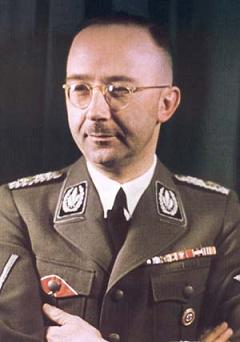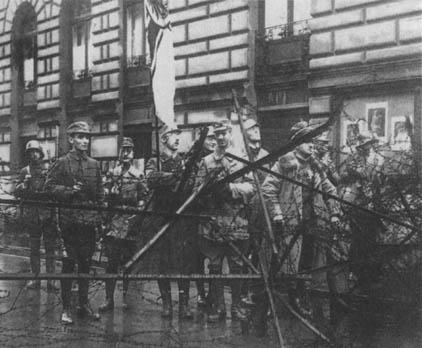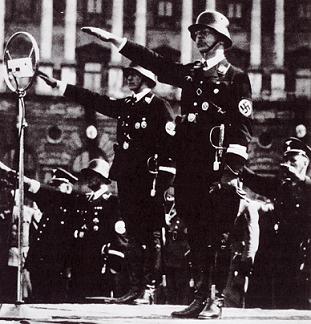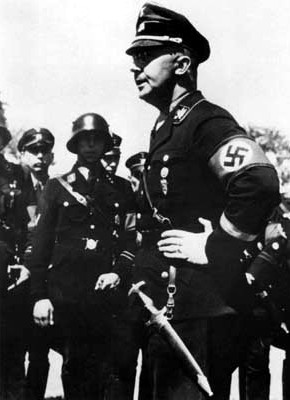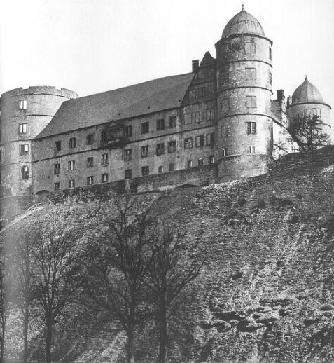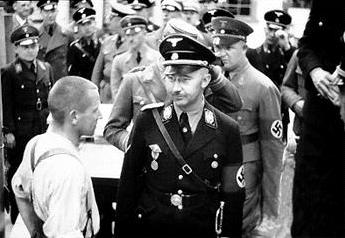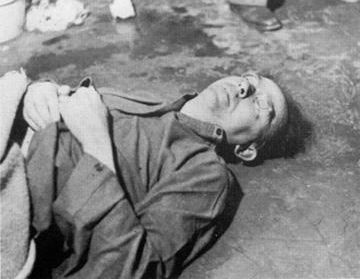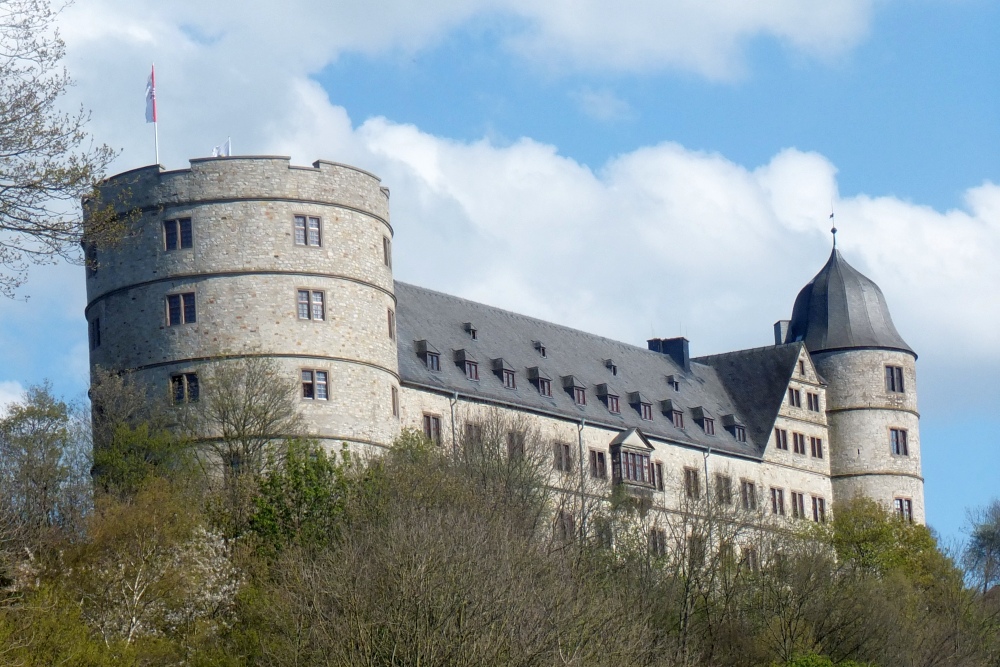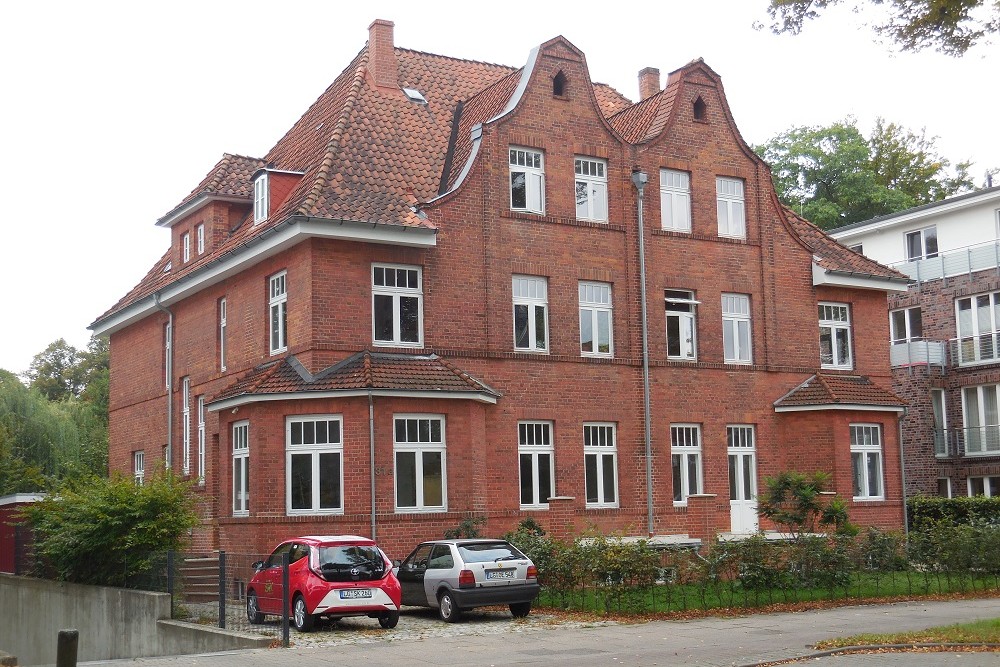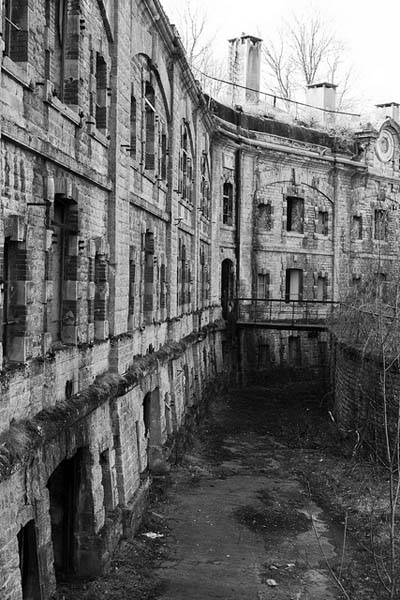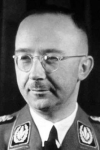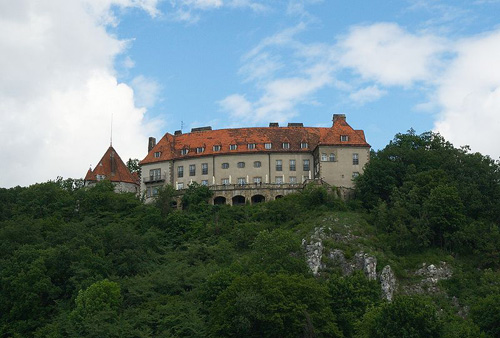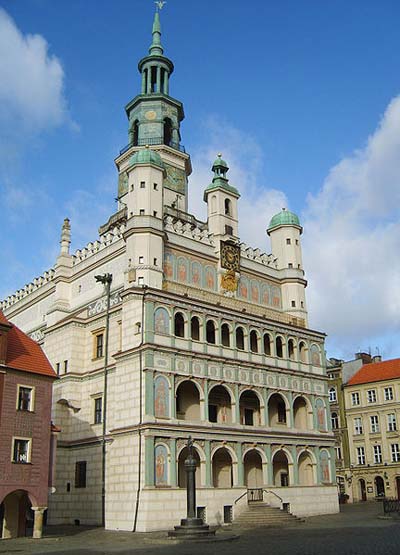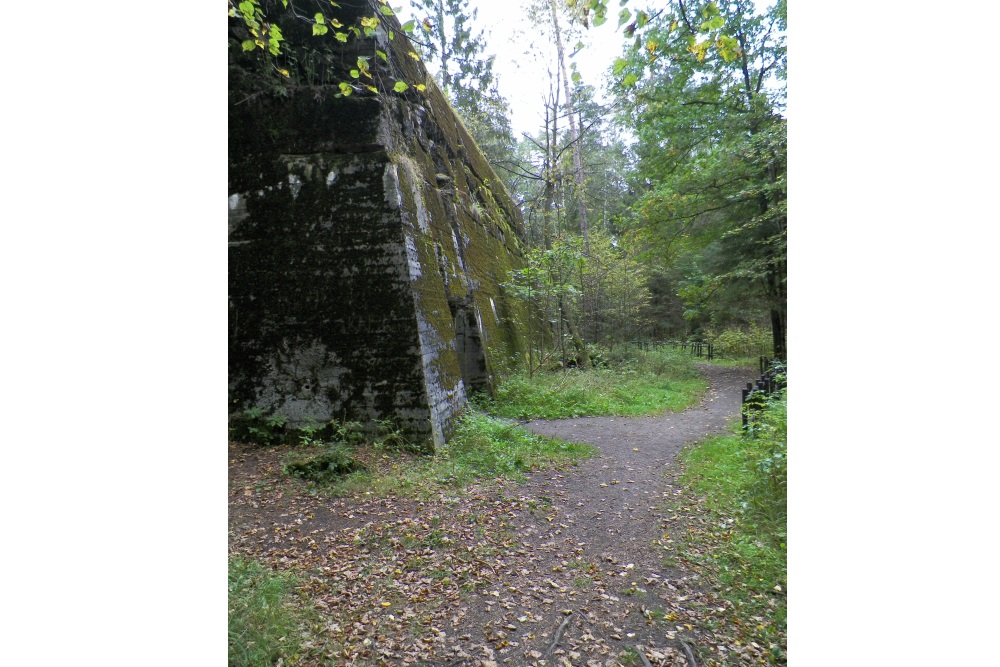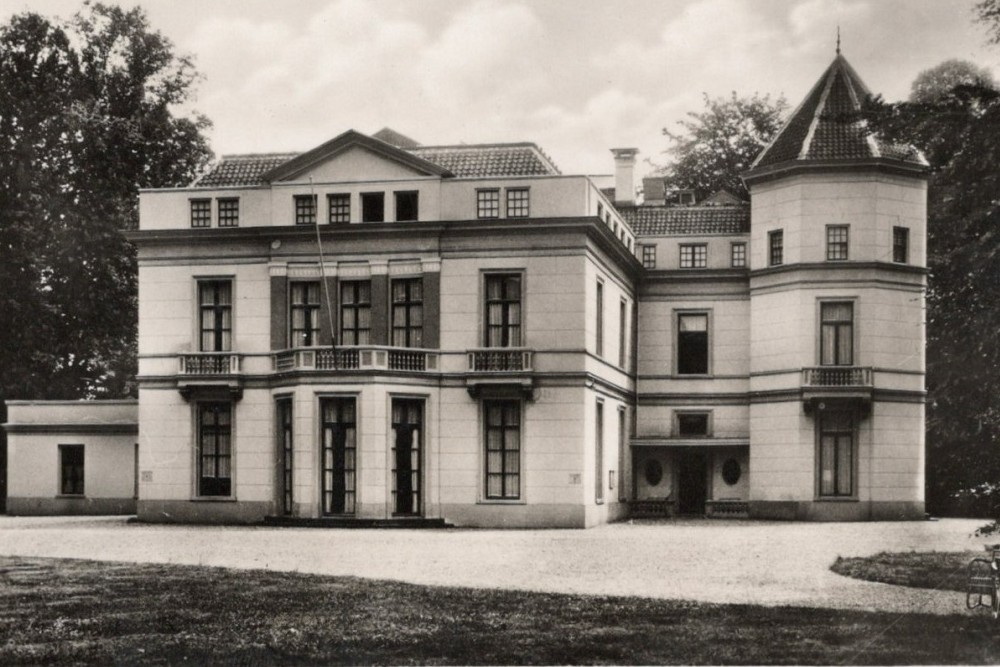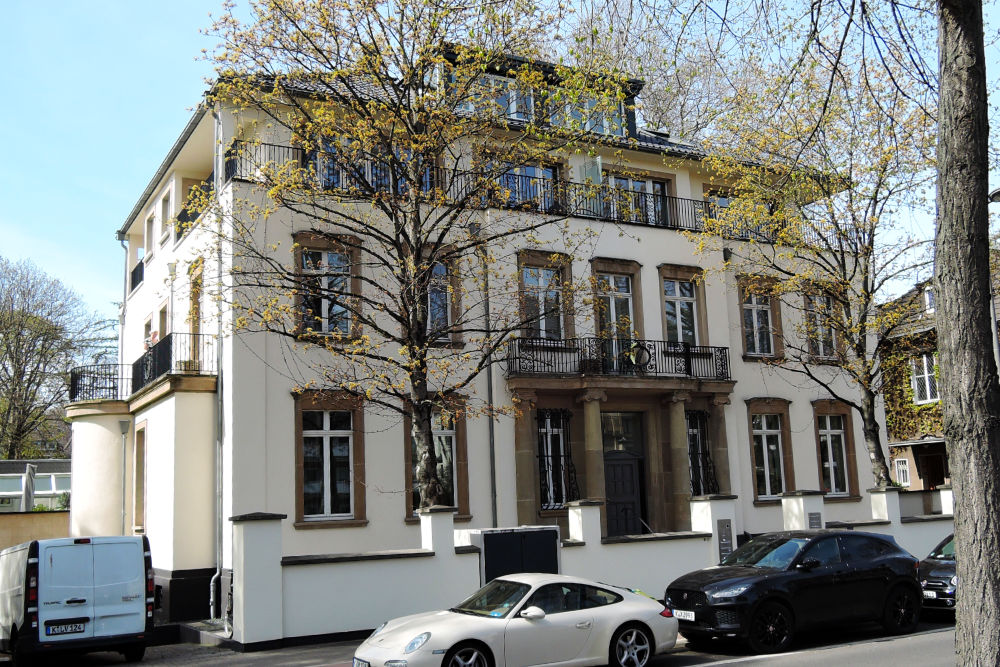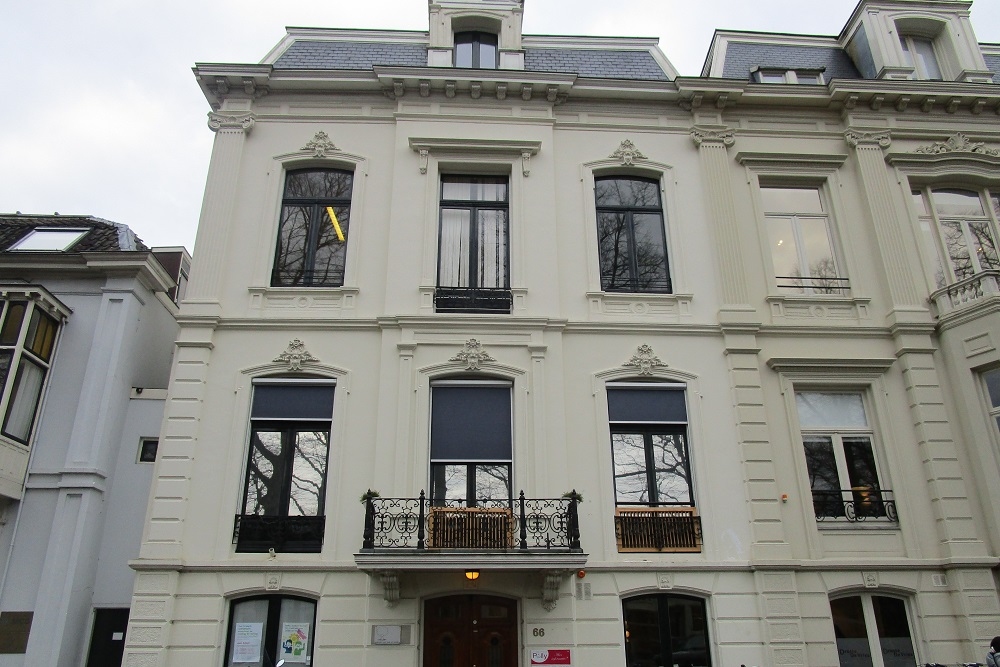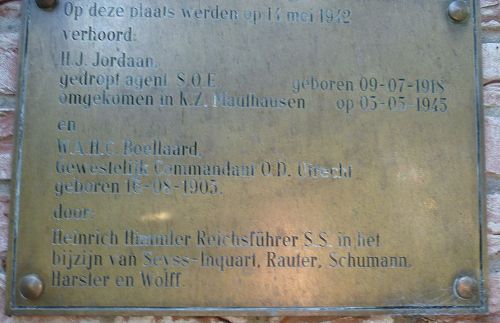Young Himmler
Heinrich Himmler was born October 7th, 1900 in Munich, second son of the catholic director of a school, Gebhard Himmler and his wife Anna. He was named after his godfather, the Bavarian Prince Heinrich von Wittelsbach. As it was, the wealthy Himmler family had a good relationship with the Bavarian court. His conservative parents raised him in a very stern catholic and nationalistic fashion.
Himmler had a poor health, just like Goebbels. He was frequently absent from school but compensated for his physical weakness by studying hard. He graduated from secondary grammar school in Landshut with top marks in history, ancient languages and religion. At the outbreak of World War One, young Himmler dreamt of a military career. He desperately wanted to become a naval officer but was rejected for his nearsightedness. The general rule was that people wearing glasses were not accepted by the navy. Therefor he reported to the army and was posted as cornet in 11th Bavarian Regiment. He was never deployed at the front, however. After he had graduated from officer’s course, the war had ended.
After the war, he went on to study agriculture at the Technical High School in Munich, graduating on August 1st, 1922. Himmler was an inconspicuous, rather shy young man who did not associate well with his contemporaries. In an attempt to being accepted more, he joined a number of associations, including the student association Apollo and the Deutsche Gesellschaft für Züchtungskunde (German Association for Breeding Science). In 1919, like many other soldiers, he joined one of the numerous paramilitary Free Corpses. These corpses engaged in opposition against the Treaty of Versailles and the threat of Bolshevism. For their badge, they often chose the deathhead, the traditional badge of the elite units of the Prussian cavalry. Strangely enough, these Free Corpses defended for a time the government they despised. The socialist Ebert government was being threatened by the Spartacus revolution. Germany appeared to be heading in the same direction as the Soviet Union. To counter this revolution, the government called on the Free Corpses for protection. After the suppresion of the Spartacus revolts, the Weimar government abandoned the Free Corpses. One man however would stand up for them. That man was Adolf Hitler who took his first steps in the political arena in Munich, not by coincidence as Munich was a national centre of opposition. The Free Corpses, of which Himmler was a member also, were to form the base of the later shocktroops of Hitler, the SA and the SS.
After his studies, Himmler was employed by the fertilizerworks Stickstoff-Land in Schleissheim. In the summer of 1923, Himmler joined the N.S.D.A.P. During the Munich putsch, under command of Ernst Röhm and with his brother, he took part in the occupation of the Ministry of War. The putsch failed and Hitler and many others including Ernst Röhm, were imprisoned. In 1925, the N.S.D.A.P. and the SA were founded anew. Himmler, who had been working for Georg Strasser (an important NS politician) in the meantime, rose to deputy Gauleiter (regional partyleader) of Niederbayern-Oberpfalz. Up until 1930 he was deputy chief of statepropaganda and in 1927, he was appointed deputy Reichsführer-SS.
Definitielijst
- cavalry
- Originally the designation for mounted troops. During World War 2 the term was used for armoured units. Main tasks are reconnaissance, attack and support of infantry.
- Gauleiter
- Leader and representative of the NSDAP of a Gau.
- putsch
- Coup, often involving the use of violence.
- Regiment
- Part of a division. A division divided into a number of regiments. In the army traditionally the name of the major organised unit of one type of weapon.
- revolution
- Usually sudden and violent reversal of existing (political) the political set-up and situations.
- Soviet Union
- Soviet Russia, alternative name for the USSR.
Images
Reichsführer-SS Himmler
July 3, 1928, Himmler married nurse Margarethe Boden, a few years his senior. The money of her dowry enabled him to set up his own agricultural enterprise, raising chickens; without success though and in 1928 he became Hitler’s immediate subordinate. As the Führer’s direct associate he defended his idea of an elite within the party, a group of men, unconditionally loyal to Hitler and the Nazi ideals. Himmler saw in the SS the possibility to create the ideal elite. Hitler meanwhile also felt the need of of a dedicated group that would protect him against his political enemies as well as against his own partymembers. The group should be headed by someone he could trust implicitly and who would do as he was ordered: Himmler was the most suitable person for this. On January 6, 1929, he was appointed Reichsführer-SS. Later on, in 1933, Hitler ordered the establishment of a special bodyguard that should see to his personal safety. In September 1933, he granted the chosen group of men their own banner and name: the Leibstandarte-SS Adolf Hitler. From then on, this SS unit, the first to be officially armed and billeted in barracks, was inextricably tied to Hitler’s life.
When Himmler took office as Reichsleiter-SS, the Schutzstaffel (SS) did not amount to much. The members, some 280, constituted a small element within the much larger Sturmabteilung (SA). Some sort of elite feeling of being the most loyal and fanatic followers of the Führer prevailed however. This feeling was even enhanced in 1926 when Hitler handed them the blood flag, which had flown at the failed Munich putsch. Selection of the men was rigidly guarded. Members could not be over 35 or under 23. They had to be disciplined, tough and above all loyal, loyal to the Führer. The name Schutzstaffel was abbreviated to SS and depicted in runic characters as two lightning flashes. Julius Schreck and Josef Berchtold had been in charghe of the SS until the end of the 20s when Erhard Heiden took over. He imposed a strict regime that stipulated what members were allowed to do and what not. Whoever did not adhere to the strict discipline was punished severely.
Yet, the definite breakthrough of the SS came with the appointment of Himmler as Reichsführer-SS. He wanted to create a guard not unlike the Roman Pretorian Guard. This personal guard was to execute Hitler’s will without asking questions. It was not for nothing that the slogan Meine Ehre heisst Treue (My honour is named loyalty) later appeared on the uniforms of the SS. Himmler drafted a recruting programme to further expand the SS into an elite unit. The major criterium was race. Only the good, racially pure German could join. Despite the rigid selection criteria, the number of members increased lightning fast: early 1930 1.000 members, in June 1934 already 50.000.
In the same period, the well known black uniform was adopted. That way the distinction between the brown uniform of the SA became clearer. The SS was officially split off but the command structure was retained though. While the SS expanded and became stronger, the SA went through a crisis. Especially in Berlin, SA units were no longer in line with Hitler and his followers. Led by SA-Oberführer Walter Stennes, his units revolted in April 1931. Supported by SA leaders from Brandenburg, Hessen, Silesia and Pommerania they ousted Gauleiter Goebbels, among others. Owing to lack of funds, the revolt quickly petered out. Hitler openly congratulated the SS because they had risen against the rebellion. In a letter to the Berlin SS leaders he wrote: "Your honour is your loyalty" These words were adopted as their slogan, as mentioned before.
As a result of the problems within the SA, Himmler strengthened discipline and harshness within the SS. He wanted to avoid at all cost that his organisation should head in the same direction as the SA. Among other things, secrecy was tightend, all SS members were sworn to secrecy about anything connected to the service. This obligation of secrecy was even extended to partymembers.
Definitielijst
- Führer
- German word for leader. During his reign of power Adolf Hitler was Führer of Nazi Germany.
- Gauleiter
- Leader and representative of the NSDAP of a Gau.
- Leibstandarte
- Elite troops, originally Hitler’s body guards. Starting as a motorized infantry regiment it grew into a Panzer division.
- Nazi
- Abbreviation of a national socialist.
- putsch
- Coup, often involving the use of violence.
- Schutzstaffel (SS)
- The Schutzstaffel commanded by Heinrich Himmler was a very powerful organisation within the Third Reich. The original goal of the SS was to protect Adolf Hitler and other Nazi’s but soon the SS was deployed for several military, security and police tasks. The SS guarded inter alia the concentration camps and manned the Einzatzgruppen. The armed branch of the SS was the Waffen-SS.
- Sturmabteilung
- Storm detachment. Semi-military section of the NSDAP. Founded in 1922 to secure meetings and leaders of the NSDAP. Their increasing power was stopped during “The night of the long knives”, 29 and 30 June 1934.
Images
Seizure of power: The night of the long knives
In June 1931, Himmler met Reinhard Heydrich. He was so impressed by this strong young man that he ordered Heydrich to draft plans for the establishment of a security service. In August of the same year, the Sicherheitsdienst (SD) was founded. Both men gradually drew more and more control over the police to themselves.
One organisation was in the way of the expansion of the SS: the SA led by Ernst Röhm. He increasingly laid claim to Hitler’s position. Apart from Hitler it was to both Himmler’s and Göring’s advantage to break the power of the SA. Göring also aspired Hitler’s position and Röhm stood in the way of the future of the SS.
Himmler’s SS therefore played an important role in the so called Night of the Long Knives. In conjunction with Heydrich’s SD they "discovered ample evidence" for a large scale conspiray by the SA to depose of Hitler. On hearing this news, Hitler called a meeting in Hotel Hasselbauer in Bad Wiessee. June 30, 1934, Hitler arrived in Bad Wiessee, accompanied by the SS and personally arrested Röhm. In the next 24 hours, another 200 SA oficials were arrested, many of them were executed on the spot. Non-members of the SA like Gregor Strasser, Kurt von Schleicher and General Ferdinand von Bredow were also murdered. Hitler was reluctant to execute Röhm, after all one of his former brother-in-arms. Only after being urged by Göring and Himmler did Hitler accept that the SA leader should die. SS man Theodor Eicke, future commander of camp Dachau, and SS-Sturmführer Michael Lippert shot Röhm. Viktor Lutze became the new leader of the SA.
Next to Hitler, Himmler emerged as the great victor of the internal struggle. He became the chief of the entire German police, hence also of the Gestapo. The police was no longer answerable to the Minister of Internal Affairs but became an instrument of power in the hands of a dedicated follower of the Führer.
Under Himmler’s direction, the SS evolved into a complex organisation. The civil Allgemeine-SS formed the main branch that mainly focused on political and administrative matters. Apart from that stood the Gestapo (Geheime Staats Polizei, secret state police) and the SD (Sicherheitsdienst, security service). Finally the SS-Totenkopfverbände (deathhead units), responsible for the guarding of the concentration camps and the Verfügungstruppen (standby troops). This last group represented the military branch of the SS; after the campaign in France, it was renamed the Waffen-SS. In this way, Heinrich Himmler became the most important and most feared leader of the Third Reich after Hitler.
Definitielijst
- Führer
- German word for leader. During his reign of power Adolf Hitler was Führer of Nazi Germany.
- Night of the Long Knives
- Night of 30 June to 1 July 1933 during which Hitler killed many of the demanding leaders of the SA, including Ernst Röhm.
- Sicherheitsdienst (SD)
- The national socialistic intelligence and counterespionage service of the SS.
- Totenkopfverbände
- Death’s head regiments. Special formation inside the Schutzstaffel (SS) that was deployed to guard concentration camps.
- Waffen-SS
- Name of Military section of the SS.
Images
The myth of the blood
It was Heinrich Himmler’s wish to develop the SS to a political, racil and mental elite. The SS should not simply be a well organised band of soldiers. Physical characteristics were very important: Himmler issued selection criteria; for instance, applicants should be at least 5 foot 5 tall because he assumed a racially outstanding person should possess certain physical characteristics. Surprisingly enough, Himmler himself did not match these criteria. Apart from the physical characteristics, applicants were also selected by belief and race. Of course, the SS man should be a racially pure person to whom National socialism was not a political movement but a firm conviction. Himmler dreamt of tall, blond-haired, blue-eyed Herrenmenschen (supermen).
In order to realize this kind of ideas, Himmler issued a Zeugungsbefehl (procreation order) for the entire SS on October 28, 1939. He considered SS men Herrenmensche (supermen) who were therefore suitable to sire children of "good blood". The action Lebensborn should be considered in this context as well. Himmler was of the opinion that every racially pure woman should become a mother, whether in or out of wedlock. He provided Zeugenhelfer (studs, men to father a child) to unmarried women. Himmler considered monogamy a sin, an immoral decree by the church. True to his own philosophy, he had a mistress in addition to his wife, who gave him two children.
Himmler saw the SS as a esoteric society, a closed community with a communal ideology and ethos. He found his inspiration in history such as the Teutonic Order of Knights. Many elements of the Nazi ideology referred to ancient ideas and values. It is not by co-incidence that the colours of the SS, black and white, where the Teutonic colours once. The Teutons distinguished themselves from other orders by recruiting Germanics only. The defeat at Tannenberg in 1410 spelled the end of the Teutonic Order but its myth lived on. Hundreds of years later, General von Hindenburg gained eternal glory by defeating the Russians at exactly the same spot. In the 30s, the SS revived the Teutonic myth completely. Thus Himmler commemorated the death of Hendrik I (876-936) each year. Hendrik I was considered the inspirator of the Teutons and and the unifier of the Germanics. Himmler believed the Germanics would recognize a great leader once in every 1.000 years. 1936 was 1.000 years after the death of Hendrik I. Obviously, there had to be a successor and to Himmler, that could only be Hitler. Towards the end of the war however, he began to doubt this theory increasingly and he considered himself the re-incarnation of Hendrik I.
Himmler looked for a place where he could establish a centre, dedicated to the study of the racial theory and which could serve as a place of worship for the SS. In the vicinity of Paderborn, he discovered the ruins of an ancient Hun Castle, the Wewelsburg. He had it rebuilt from 1934 onwards because this was where he wanted to establish a new order of Teutonic knights in the tradition of King Arthur. Himmler let himself be called Grand Master in the Teutonic Order of Knights and adopted the habit, emulating the legendary King Arthur, of receiving the 12 most respectable SS leaders at a round table.
Himmler’s ultimate goal was to replace Christianity by an Arian religion as a base for Nazi ideology. According to Himmler, many Christian symbols had been stolen from an older Arian religion. He wanted to re-instate these symbols like the SS runic characters and the swastika. Another symbol, appealing to the imagination was the Holy Grail. One of the main researchers was Otto Rahn. He was a young academic who published works about the Cathars, among others, who he thought were the last who were in possession of the Holy Grail. Rahn was taken in by the SS where he could continue his research. In 1938, he died though under mysterious circumstances. Meanwhile quite a number of parties and ceremonies had been held with the purpose of welding the entire SS into one communiy. Ever more old Arian habits were introduced. The Christian calendar was rejected. Henceforth, the year was divided by the ceremonies of the summer and wintersolstitium, the birthdays of the Reich and the Führer and the commemoration of the dead. In addition, Hebrew names of saints were scrapped and replaced by Germanic names.
In 1935, Himmler founded a new branch within the SS, namely the Ahnenerbe. This SS university studied Germanic antiquity in order to corroborate Nazi beliefs with scientific evidence. In 1937, Himmler said about the Ahnenerbe: "It is charged with scientific research and study of ancient history. Seen from a scientific and ideological point of view, our task is to study the facts in an objective manner without falsifying them>" Institutions like that should lend Nazi propaganda the status of objective truth. Himmler’s ideologic and religious views had a profound influence on the university. This statement by one of the researchers is characteristic: " After more than 1.000 years of Jewish-Christian mental dictatorship in Europe, we think everything has to be proven anew!". With the outbreak of war, the research of the Ahnenerbe faded into the background. The university had to contend itself more with activities in connection with the new reality. These activities were focused more on medical research in which inmates of concentrationcamps played a tragic leading role.
Hitler showed no interest in Himmler’s occult and religious activities. He did not concern himnself with what happened in and around the Wewelsburg. In Mein Kampf he had already condemned the people’s occultism. Yet Hitler did accept Himmler’s irrational leanings. The reason was his efficiency: the conduct of the chief of the SS was always goal oriented and efficient and moreover, Himmler had proved himself meanwhile as one of Hitler’s most loyal followers.
Definitielijst
- dictatorship
- A form of government where the power in a country is in the hands of one person, the dictator. Originally a Roman regime in case of an emergency where total power would rest with one person during six months in order to face a crisis.
- Führer
- German word for leader. During his reign of power Adolf Hitler was Führer of Nazi Germany.
- ideology
- A collection of principles and ideas of a certain system.
- Lebensborn
- Meaning “Fount of life”. Programme of the SS with the aim of breeding the Aryan super race. In special homes Aryan women were impregnated by Aryan SS-officers
- Mein Kampf
- “My Struggle”. Book written by Adolf Hitler, outlining the principles of National Socialism.
- National socialism
- A political ideology drawn up by Hitler based on the superiority of the German race, the leader principle and fierce nationalism that was fed by the hard Peace of Versailles. National socialism was anti-democratic and racist. The doctrine was elaborated in Mein Kampf and organised in the NSDAP. From 1933 to 1945 National socialism was the basis of totalitarian Germany.
- Nazi
- Abbreviation of a national socialist.
- propaganda
- Often misleading information used to gain support among supporters or to gain support. Often used to accomplish ideas and political goals.
- socialism
- Political ideology aiming at slight or no class differences. Means of production are owned by the state. Evolved as a response to capitalism. Karl Marx tried to substantiate socialism scientific.
- swastika
- Equilateral cross, symbol of Nazi-Germany.
Images
The teacher turns executioner
Himmler’s name is connected with the darkest period in German history: the concentration camps. He firmly believed in the missionary task of the Führer and in National socialism. As already mentioned, the SS developed into a complex organisation with many branches. Some of those waged a battle of extermination, based on race, namely the cleansing of Europe of non-Arian elements (read: the extermination of people like the Jews). Himmler created the framework in which this became possible.
Nevertheless, the picture of Himmler as a blood thirsty sadist did not match reality. From numerous oral and written statements, Himmler emerges as a shy person who shunned interest and publicity, someone who loathed blood and fainted at the sight of an execution. He preferred working behind closed door on files he kept meticulously. Yet he was the person responsible for the concentration camps and the death of millions of people. Himmler ordered mass executions and the medical experiments on prisoners. How can this ambiguous attitude be explained?
The answer lies in the morale he developed, namely the murderer with the clean conscience. He considered his SS men not a gang of sadistic murderers but saw them as the instruments to complete a higher task: "There are circumstances in which civil judgement is inadequate and the individual must be judge and executioner sometimes, not because he would be blood thirsty and cruel but because the honour of society would demand it in order to maintain the soul and the life of the people". Himmler considered the extermination of the Jews and other Untermensche (subhumans) a grand task that just had to be carried out. Characteristic of this ambiguity is the severity towards SS men who had taken possession of Jewis property. "We had the moral right, we have the duty towards our people to annihilate this people that wanted to annihilate us. But we do not have the right to enrich ourselves with furs, a watch, even one Mark, one cigarette or anything else. (…) All in all, we can say we have carried out one of the most difficult tasks for the love of our population. And our iner self, our soul and our personality have not suffered". In Himmler’s philosophy it was perfectly possible to have dozens of people shot and still retain a clean conscience.
In 1933, Himmler established the first concentration camp in Dachau near Munich. Initially, mainly German communists, socialdemocrats and other political opponents were imprisoned there. Soon, gypsys, homosexuals and Jehova’s witnesses arrived. After the Kristallnacht, the massive influx of Jews began. The Dachau camp became the training ground for SS camp guards and the structure and daily running of the camp served as a model for the future Nazi concentration camps.
The people coming into the concentration camps were no longer considered human by Himmler. He distinguished three types of living beings: humans, animals and Untermensche (subhumans). These were Jews, homosexuals, gypsys, asocials, communists and other political opponents. They were branded by the Nazi ideology and dehumanized. Their being human was denied them. One did not have to show compassion for creatures that were primitive and mentally inferior to animals. This method of dehumanizing one’s victims is one of the explanations for the fact that human beings were capable of that kind of cruelties and still are.
In the summer of 1941, Himmler designated Auschwitz, commanded by Rudolf Höss, as the pilot project for the Endösung der Judenfrage (Final solution of the Jewish question). The camps already in existence in the eastern part of the Third Reich were not (yet) suitable to carry out this massive operation. That is why Himmler picked Auschwitz. Adolf Eichmann was resposible for the transport of the Jews, Rudolf Höss saw to their extermination. Himmler also coined the phrase Arbeit macht Frei (Labour liberates) above the entrance gates to the camp. He defined the purpose of the camps as follows: "Hard labour creating new values, a stern but fair treatment (…) The slogan of these camps reads: There is a road to freedom"
In reality, things progressed very differently. Camps like Auschwitz, Chelmno and Majdanek were true exterminationcamps. For the inmates, there was no road to freedom, just a straight path to death. 4.000 SS men, organised in the Totenkopfverbände (deathhead brigades), made up the guards. In addition there were the SS physicians who carried out all sorts of medical experiments on inmates with permission from Himmler. He was for instance, highly interested in the hypothermal tests conducted by Dr. Sigmund Rascher. Himmler himself proposed to warm half frozen inmates using biological warmth. When a few coworkers refused to co-operate, the Reichsführer-SS reacted vehemently: "A young German pilot may risk his life but the life of a criminal would be too valuable for this?" In other camps, inmates were injected with contagious diseases in order to test vaccins. These and many other horrendous experiments claimed the lives of many inmates.
Meanwhile in Poland and the Soviet Union, the Einsatzgruppen (special action squads) were fully operational. These men, selected from the SD and the Sicherheitspolizei (security police), saw to the extermination of Jews, Soviet Kommissars and others considered inferior. The Einsatzgruppen alone accounted for hundreds of thousands of victims. They carried this out extremely meticulous; Himmler’s bookkeepers mentality had taken hold. They often kept files on the data of executions and the number of victims.
Only at war’s end, it became clear what destruction, especially the SS under Himmler had caused: more than 5 million Jews exterminated, more than 500.000 gypsys murdered, nearly half a million Soviet prisoners of war executed and tens of thousands sick and disabled gassed.
Definitielijst
- concentration camp
- Closed camp where people are being held captive that are considered to be anti- social, enemies of the state, criminal or unwanted individuals. These groups mostly do not get a fair trial or are condemned to doing time in a camp.
- Führer
- German word for leader. During his reign of power Adolf Hitler was Führer of Nazi Germany.
- ideology
- A collection of principles and ideas of a certain system.
- Jews
- Middle Eastern people with own religion that lived in Palestine. They distinguished themselves by their strong monotheism and the strict observance of the Law and tradition. During World War 2 the Jewish people were ruthlessly persecuted and annihilated by the German Nazis. . An estimated 6,000,000 Jews were exterminated.
- moral
- The will of the troops/civilians to keep fighting.
- National socialism
- A political ideology drawn up by Hitler based on the superiority of the German race, the leader principle and fierce nationalism that was fed by the hard Peace of Versailles. National socialism was anti-democratic and racist. The doctrine was elaborated in Mein Kampf and organised in the NSDAP. From 1933 to 1945 National socialism was the basis of totalitarian Germany.
- Nazi
- Abbreviation of a national socialist.
- socialism
- Political ideology aiming at slight or no class differences. Means of production are owned by the state. Evolved as a response to capitalism. Karl Marx tried to substantiate socialism scientific.
- Soviet Union
- Soviet Russia, alternative name for the USSR.
- Totenkopfverbände
- Death’s head regiments. Special formation inside the Schutzstaffel (SS) that was deployed to guard concentration camps.
Images
Operation Himmler: the beginning of WW 2
It is known that Hitler wanted to expand Germany’s Lebensraum (space to live). The German nation laid claim to a larger part of Europe. Therefore he focused on the large territories in eastern Europe. The question was where this space was easiest to achieve. The answer did not lay in far away colonies overseas but within Europe itself. The Third Reich turned its attention first to those areas already inhabited by many Germans and German speaking people. This tactic gained a lot of success as Hitler managed to annex Austria and Czechoslowakia without unleashing a war.
This was however not enough for the ambitious Nazis. Poland seemed the next easy victim. In order not to anger the Soviet Union with this expansion to the east, Hitler dispatched his Minister of Foreign Affairs, Joachim van Ribbentrop, to Moscow in 1939. There he met Vjatsjeslav Molotov, the Soviet Minister of Foreign Affairs. A non-agression pact was signed, the Molotov-Ribbentrop pact (Pact 23-08-1939). In a few secret protocols, a partition of Poland was also agreed upon. Now, the Nazis still needed a good excuse to invade Poland. Himmler came up with a plan, hence it was called Operation Himmler. The plan called for a simulated attack by Poles on the radiostation at Gleiwitz.
Alfred Naujocks of the SD and Heinrich "Gestapo" Müller were responsible for Operation Himmler (statement Naujocks). A small company of German soldiers was deployed. In addition, Naujocks and Müller had a dozen inmates from concentration camps at their disposal. These were dressed in Polish uniforms, were administered a lethal injection and subsequently riddled with bullets to make it look like they had died in a confrontation with the Germans. At the same time, a Polish speaking German would deliver a speech, scolding the Nazis and Hitler and calling for a war of liberation. This faked attack heralded the beginning of World War Two. A few hours after the incident, on September 1st, 1939, German units invaded Poland. Fall Weiss had begun.
Ultimately, this simulation did not have the desired effect on propaganda. Himmler though was really proud of it: "A colossal day for me. Operaton Himmler has fullfilled the Führer’s wishes. I shall always look back on my plan and its success in pride".
Definitielijst
- Führer
- German word for leader. During his reign of power Adolf Hitler was Führer of Nazi Germany.
- Lebensraum
- “Living space”. Nazi term indicating the need for the overpopulated German lands to expand.
- Molotov-Ribbentrop pact
- Monstrous alliance and non-aggression pact between Nazi-Germany and the Soviet-Union in 1939 involving a secret protocol dividing the countries of Eastern Europe.
- propaganda
- Often misleading information used to gain support among supporters or to gain support. Often used to accomplish ideas and political goals.
- Soviet Union
- Soviet Russia, alternative name for the USSR.
The executioner turns traitor
The defeat of the German 6th Army at Stalingrad in early 1943 marked the beginning of the end. The fortunes of war turned increasingly against the Third Reich. A few officers wanted to avoid the worst by disposing of Hitler. The attempt on Hitler and the subsequent coup failed however. This event brought Himmler in a dire situation. How was it possible that someone with his widespread intelligence network was not aware of the conspiracy? Moreover, Himmler knew some of the major conspirators very well, such as Walter Schellenberg, his chief of the foreign intelligence office and the Berlin lawyer Carl Langbehn. Probably they had not informed Himmler about their plot. It is certain however that Langbehn, long before July 20, had spoken about an alternative attitude towards the Allies in a conversation with Karl Woff, a general in the SS and a confidant of Himmler’s. Meanwhile it is also clear that Himmler knew about resistance groups within the Wehrmacht, among others. It appears therefore that Himmler recognized the necessity of a coup but expected others to do the dirty work.
Early 1945 it was clear that the Third Reich was on its last breath. Himmler tried to save whatever could be saved. He secretly negotiated with the World Jewish Congress about the release of Jewish prisoners from the concentration camps. He made quite a number of false promises to save his skin. Among other things, he promised that inmates would not be executed and that the camps would be transferred to the Allies unscathed. At the same time however, the death marches began, the evacuation of the camps in the east. After having millions of Jews on his conscience, he now portrayed hinself durnig these negotiations as the great saviour and protector of the prisoners. On April 23, 1945, Himmler entered into negotiations with Count Folke Bernadotte, a Swede. The Reichsführer-SS was willing to capitulate on the western front but wanted to continue fighting in the east. Himmler was firmly convinced the Allies would negotiate with him. Obviously he had lost touch with reality to such and extent that he did not doubt the Allies would accept his generous offer. Moreover he believed Hitler would name him as his successor.
He had however not taken the western Allies and the press into account. The west refused to accept Himmler’s offer but the news had leaked out in the meantime. When Hitler heard the messages, he was furious. He had never expected this treason by the treue Heinrich (loyal Heinrich). On May 1st, 1945, Grossadmiral Dönitz was appointed Hitler’s successor and on May 6, Himmler was stripped of all his functions. The role of the once powerful Reichsheini was over. There was nothing left but to go into hiding.
On May 22, 1945, Himmler was arrested with a number of SS adjutants near Hamburg. Meanwhile he had shaved off his moustache and wore a black eye patch instead of his glasses and he introduced himself as Sergeant-major Heinrich Hitzinger. None of the British soldiers suspected that one of the most important leaders of the Nazi regime stood before them. However, when he had to stand in line, just like the other prisoners and received no preferential treatment, he made himself known. He still thought he had the right to a preferential treatment. The next day he was obliged to undergo a medical examination. The Allies knew meanwhile they had to be wary of the cyanide capsules prominent Nazis were carrying. When the doctor asked him to open his mouth, he crushed the capsule. The doctors present did try to get the poison out of his system using emetics but in vain, the most feared man of the Third Reich was dead. Himmler was, like many of his victims, buried anonimously, in the vicinity of Lüneburg.
Definitielijst
- Jews
- Middle Eastern people with own religion that lived in Palestine. They distinguished themselves by their strong monotheism and the strict observance of the Law and tradition. During World War 2 the Jewish people were ruthlessly persecuted and annihilated by the German Nazis. . An estimated 6,000,000 Jews were exterminated.
- Nazi
- Abbreviation of a national socialist.
- resistance
- Resistance against the enemy. Often also with armed resources.
- Wehrmacht
- German armed military forces, divided in ground forces, air force and navy.
Images
Information
- Article by:
- Gerd Van der Auwera
- Translated by:
- Arnold Palthe
- Published on:
- 19-12-2015
- Last edit on:
- 03-11-2023
- Feedback?
- Send it!
The War Illustrated
Related sights
Sources
- VAN CAPPELLE,H., VAN DE BOVENKAMP,P.Hitlers handlangers. Soest, 2004.
- REIDER,F. Geschiedenis van de SS in beeld. Opkomst en ondergang der zwarte orde. Antwerpen, 1985.
- GOLDHAGEN,D.J. Hitlers gewillige beulen. Antwerpen, 1996.
Websites:
- Jewish Virtual Library: Heinrich Himmler
- Jewish Virtual Library: Dachau
- www.wsws.org
- Go2War2: Molotov-Ribbentroppact
- Go2War2: Gangsters in Gleiwitz
